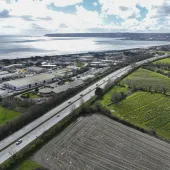National Highways launches £1 billion concrete roads framework
National Highways has launched the tender process for its £968 million framework to replace and reconstruct concrete roads across England.
The programme will tackle around 644 kilometres of road originally built between the 1960s and 1980s, many of which are now reaching the end of their design life. The work will take place over six years, from November 2025 to November 2031.
The “legacy concrete roads reconstruction framework” will address sections of road that were constructed using jointed plain concrete pavement (JPCP) and other older designs. Many of these roads, located in key areas such as the East, South East, and Midlands, now show significant wear, including surface cracking and joint degradation.
The framework forms part of National Highways’ broader Road Investment Strategy (RIS3), which runs from 2025 to 2030. It builds on the outcomes of RIS2, focusing on road modernisation and maintenance. RIS4, planned for 2030 to 2035, is expected to continue addressing the nation's long-term infrastructure needs.
The framework is divided into four regional lots, covering the East of England, South East, Midlands, and North of England. Each lot will oversee the design, construction, and temporary traffic management required for the full-depth replacement of concrete roads.
This is a departure from previous strategies, such as the £400 million framework under RIS2, which focused mainly on repairs rather than comprehensive reconstruction.
Successful contractors will also be required to meet environmental targets, such as reducing carbon emissions during construction. Advanced materials and methods are expected to play a role in minimising disruption to road users.

England’s concrete roads
Most of National Highways' network in England is surfaced with asphalt, also known as blacktop or tarmac, but some roads are built of concrete. These make up around 400 miles (4%) of the country’s motorway and long-distance A-road network.
Concrete roads are mostly found along the eastern side of England, in the North East, Yorkshire, East Anglia and the South East. There are also some small stretches in the West Midlands, Merseyside and Greater Manchester.
They were built largely in the 1960s and 1970s, when traffic volumes were half of what they are today. The concrete slabs with which they were made have proved tougher and longer lasting than asphalt, and over the years have needed very little maintenance.
Decades of safe use and hundreds of millions of journeys mean these roads are nearing the end of their working lives. They need vital upgrades to ensure they remain safe, dependable and durable. Better surfaces will also boost ride quality and reduce noise for many years to come.








